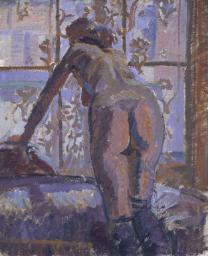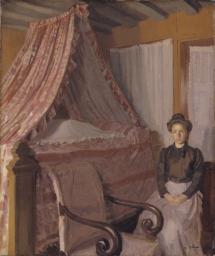Harold Gilman, ‘The Venus of Velasquez’
The Art News, 28 April 1910, p.198.
THE VENUS OF VELASQUEZ.
–––––
In the controversy about the Venus of Velasquez perhaps I may be allowed to give evidence of identification. I am as one who has been hospitably entertained by a man, and has learnt to know his every attitude and characteristic so that I can recognize him at a distance with his back turned, or by the sound of his footsteps. For I spent more than a year almost constantly in the museum of the Prado, and made several copies. The time, compared with the intimacy of a man like Señor Beruete is short – so, too, is my knowledge, compared with his, very small. In answer to the pupils of Carolus Duran I would say that it is only when I hear this clamour about the matter from men who for the most part seem to have studied Velasquez not at all, and who in most cases do not pretend to have the knowledge of painters that I speak at all.
This stuffed image of Velasquez which they have set up and with which they compare this most varied personality has hardly any likeness even to any one attitude this painter could assume. It is this stuffed image alone which always painted au premier coup, and Velasquez won’t stand still enough to be compared with it. So much has been said of his painting au premier coup, and it would be interesting to have them point out even a single picture of his which was painted in this manner. Beginning with the pictures best known to us in England, I would like to know if the head of “Phillip old” of the National Gallery, and the ‘Margarita,’ of the Louvre, are painted au premier coup. To go on to others in the Museum of the Prado. Are the dwarfs, the ‘Spinners,’ the ‘Mercury and Argus,’ the ‘Maria Theresa,’ the ‘Dwarf with a Dog, Las Meninas,’ the ‘Two Queens,’ painted au premier coup? Even the ‘Esop’ and the ‘Moenippus’ are not, though these are the nearest to it. All are painted in varying thicknesses of paint, in varying degrees of liquidity of paint, in varying smoothness and roughness, in few or many sittings; in fact, in the varying technique which alone can correspond to the moods of so great a painter, and to the circumstances of each picture. The faces of the queens and of the ‘Maria Theresa’ (in the pearl coloured dress slashed with red), are as smooth as this ‘Venus.’ The ‘Mars’ is like the ‘Cupid.’ The red curtain, which I know as well as I know my own overcoat, figures in two or three of his other masterpieces. Whence then this talk of his painting au premier coup, of Carolus Duran, or Sargent? The only thing which has any semblance to a constant method is the painting from dark to light, in the final painting, in overlapping pieces of paint, as is the case in most oil paintings until recently, resulting in the thickening of the paint towards the lights. The fact of this method having been so unusual among painters is the reason the painting by the juxtaposition of small pieces of paint of the moderns is so disliked. It is a new technique. In this way one can work from light to dark (setting the light as high as its colour will allow), or from dark to light, all over a painting at one go or labouring at part only of the canvas. One can work upon dry paint without oiling out, correct without niggling, labour without pain.
Edges of paint do not matter, for the painting is all edges as a tree is made of leaves. This is a free and natural expression. It is interesting to notice that here and there, there are signs – in for instance, the ‘Dwarf with a Large Dog,’ of the Prado, to my mind one of his greatest paintings – that Velasquez would have smiled very kindly at this new thing which is making men of less supple mind so angry now. To end – the ‘Venus’ is Spanish from corner to corner, and it is painted by Velasquez. It has been cleaned to its harm, and rubbed by the noses of “experts.” I don’t care what signature they find – Daniel Maclise and Jabez Balfour. I should think the cracks might do anything by now, and I’ve seen worse things on walls.
H. Gilman.
How to cite
Harold Gilman, ‘The Venus of Velasquez’, in The Art News, 28 April 1910, p.198, in Helena Bonett, Ysanne Holt, Jennifer Mundy (eds.), The Camden Town Group in Context, Tate Research Publication, May 2012, https://www




